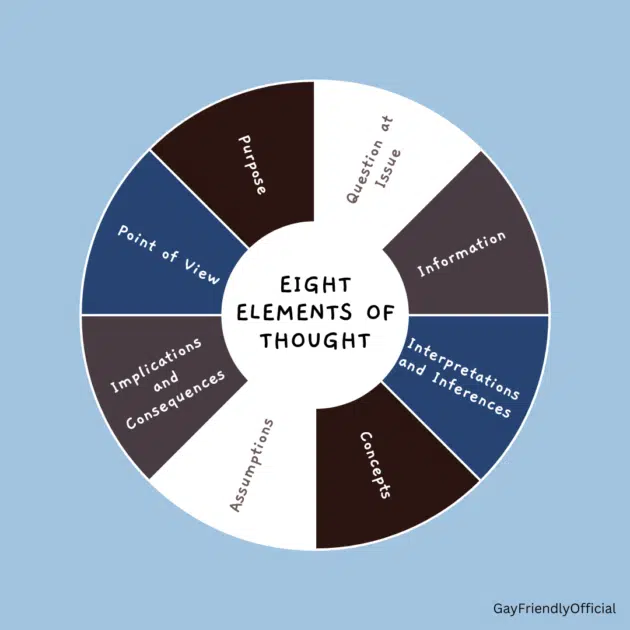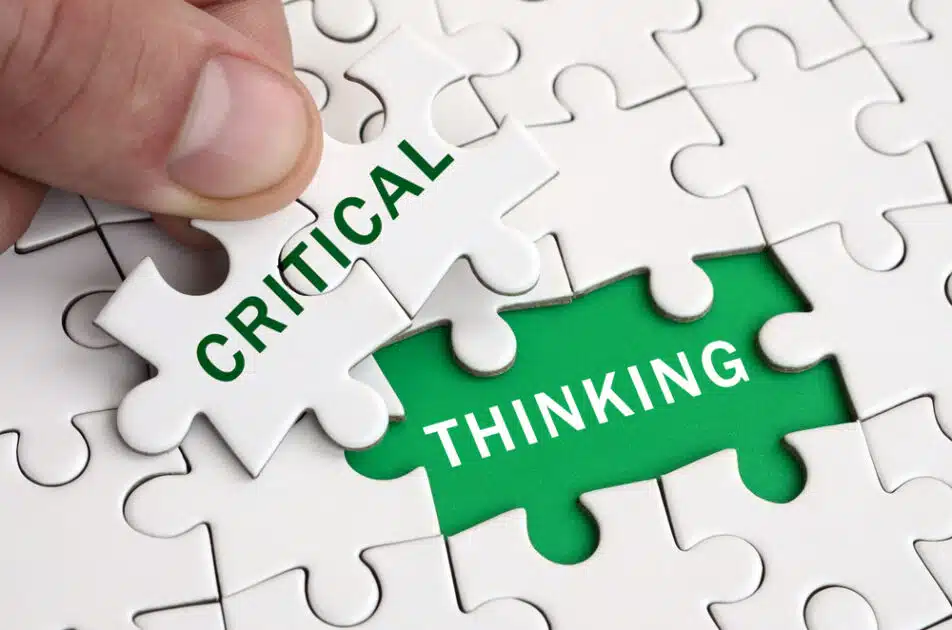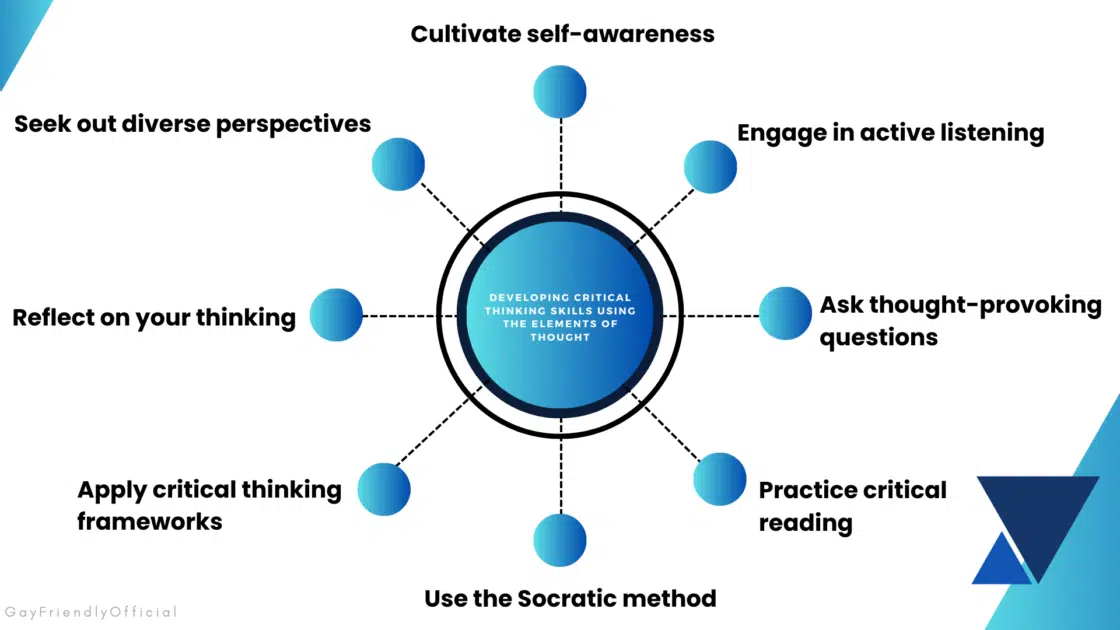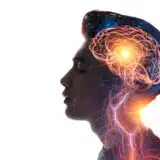Elements Of Thought – Examples And What Is Critical Thinking

How To Use The Elements Of Thought
What is Therapy? 08th Apr, 2023
Critical thinking has become an invaluable skill in today’s fast-paced and complex world. It enables individuals to analyze, evaluate, and make informed decisions in various aspects of life.
One effective model for understanding and fostering critical thinking is the Elements of Thought, developed by Dr. Richard Paul. This model breaks down the thinking process into eight interconnected components that help us think more logically and systematically.
This article will delve into the Elements of Thought, explore their connection to critical thinking, and learn how Dr. Richard Paul’s contributions to the field have shaped how we approach problem-solving and decision-making.
So, let’s embark on a journey to enhance our critical thinking skills and empower ourselves to navigate the challenges of the modern world.
Overview of the Eight Elements of Thought
The Elements of Thought provide a comprehensive framework to understand the different thinking aspects and develop critical thinking skills. Let’s examine these elements and how they contribute to the thinking process.

Point of View
Point of View refers to the perspective we approach a problem or situation. It encompasses our beliefs, values, and biases, which shape how we see the world and interpret information. By recognizing and understanding different points of view, we can enhance our critical thinking abilities and make more informed decisions.
Purpose
Purpose is the specific goal or objective that drives our thinking. It helps us to focus on what we want to achieve and guides our reasoning process. By identifying and clarifying our purpose, we can better direct our thoughts and actions toward the desired outcome.
Question at Issue
The Question at Issue is the central problem or inquiry we are trying to address. It helps us identify the core issues, frame our thinking, and determine the information we need. We can stimulate critical thinking and drive our investigation by asking clear, relevant, and answerable questions.
Information
Information is the raw data, facts, and evidence we collect and use to inform our thinking. Gathering reliable and accurate information to make sound decisions and draw logical conclusions is crucial. Assessing the credibility of sources and organizing information systematically can strengthen our critical thinking skills.
Interpretations and Inferences
Interpretations and Inferences involve drawing conclusions from the information we have gathered. These conclusions are based on our analysis, evaluation, and reasoning, and they help us to make sense of the problem at hand. By ensuring that our interpretations and inferences are logical and well-supported, we can enhance the quality of our critical thinking.
Concepts
Concepts are abstract ideas and categories that help us to organize information and understand the world around us. They provide a common language to communicate and discuss complex issues. By mastering the relevant concepts and understanding their implications, we can deepen our critical thinking abilities and engage in meaningful discussions.
Assumptions
Assumptions are the underlying beliefs and principles we accept as accurate without proof. They form the foundation of our reasoning and influence our interpretations and inferences. By examining our assumptions and ensuring they are valid and reasonable, we can improve the accuracy and reliability of our critical thinking.
Implications and Consequences
Implications and Consequences refer to the potential outcomes and effects that may result from our interpretations, inferences, and decisions.
They help us to consider the broader impact of our reasoning and to weigh the pros and cons of various options. By carefully considering the implications and consequences of our thoughts, we can make more responsible and well-informed decisions.
The Eight Elements of Thought provides a powerful tool for understanding and improving our critical thinking skills. By mastering these elements and applying them to our daily lives, we can become more effective thinkers, problem solvers, and decision-makers and navigate the complexities of the modern world with confidence and clarity.
What is Critical Thinking?

Critical thinking is the art of analyzing and evaluating thinking to improve it, encompassing creativity, imagination, and diligence. It involves examining our own thought processes and those of others to understand the reasoning behind actions and ideas.
By breaking down thinking into its components and evaluating its quality against a set of criteria, we can develop better decision-making abilities and foster personal growth.
As a result, critical thinking allows us to understand the world more deeply, better comprehend our place in it, and take well-reasoned actions to improve our surroundings.
The Importance of Critical Thinking
Critical thinking is essential in today’s rapidly changing and complex world. It enables us to analyze, evaluate, and reason effectively, empowering us to make better decisions, solve problems, and navigate the intricacies of various aspects of life. The importance of critical thinking cannot be overstated, as it plays a crucial role in our personal and professional lives.
In Personal Life
We are constantly faced with decisions, problems, and situations that require thoughtful analysis and judgment. Critical thinking helps us to:
- Make informed decisions: By applying critical thinking skills, we can weigh the pros and cons of different options, consider alternative viewpoints, and select the best course of action.
- Solve problems effectively: Critical thinking allows us to identify the root causes of problems, generate and evaluate potential solutions, and implement the most suitable approach.
- Enhance communication skills: By thinking critically, we can articulate our thoughts and ideas clearly, listen actively to others’ perspectives, and engage in constructive conversations.
- Develop self-awareness: Critical thinking promotes introspection and helps us recognize our biases, assumptions, and areas for improvement.
In Professional Life
In the workplace, employers highly value and seek critical thinking. It enables professionals to:
Improve decision-making: Critical thinking allows employees to assess situations objectively, analyze relevant information, and make well-informed decisions that benefit the organization.
Foster innovation and creativity: By thinking critically, employees can challenge the status quo, identify new opportunities, and develop innovative solutions to complex problems.
Enhance collaboration and teamwork: Critical thinking promotes open-mindedness, empathy, and respect for diverse perspectives, fostering a collaborative work environment and effective team dynamics.
Adapt to change and uncertainty: Critical thinking equips professionals with the ability to anticipate and respond to changes in the market, industry, or workplace and confidently navigate uncertain situations.
Benefits of Developing Strong Critical Thinking Skills
Developing strong critical thinking skills offers a multitude of benefits, including:
- Better decision-making and problem-solving abilities
- Enhanced adaptability and resilience in the face of change
- Improved communication and interpersonal skills
- Increased self-awareness and personal growth
- More tremendous success in academic and professional pursuits
- A deeper understanding of complex issues and global challenges
- The ability to think independently, critically assess information, and form well-reasoned opinions
Critical thinking is a vital skill that holds significant importance in various aspects of our lives. By cultivating essential solid abilities of thinking, we can make better decisions, tackle complex problems, and thrive in a dynamic and interconnected world.
Real-Life Examples of the Elements of Thought
To better illustrate the application of the Elements of Thought in different situations and contexts, let’s explore concrete examples for each of the eight elements:
- Point of View: A manager is tasked with deciding to implement a new work-from-home policy. The manager considers the perspectives of the employees, the company, and the clients. By examining these different points of view, the manager can better understand the needs, concerns, and potential benefits of the policy change.
- Purpose: A student is writing a research paper on climate change. Their purpose is to investigate the causes and effects of climate change and present evidence-based solutions to mitigate its impact. Students can focus their research and analysis on relevant information and arguments by clearly defining their purpose.
- Question at Issue: A city council is debating whether to build a new public park or a shopping center on a vacant lot. The question is: “Which development option would best serve the community’s needs and contribute to the city’s long-term growth?” By identifying the central question, the council members can evaluate the pros and cons of each option based on the defined criteria.
- Information: An entrepreneur is considering investing in a new business venture. They gather data on market trends, customer preferences, and competitor performance to make an informed decision. By collecting and analyzing relevant information, the entrepreneur can better assess the viability and potential profitability of the venture.
- Interpretations and Inferences: A teacher is grading a student’s essay. The teacher interprets the student’s arguments and evaluates the quality of their inferences based on the evidence provided. By examining the interpretations and inferences, the teacher can determine the strength of the student’s critical thinking and provide feedback for improvement.
- Concepts: A team of engineers is designing a new smartphone. They apply concepts like ergonomics, battery life, and user experience to guide their design choices. By understanding and utilizing these concepts, the team can create a product that meets consumer expectations and stands out in the market.
- Assumptions: A doctor is diagnosing a patient’s symptoms. The doctor initially assumes that the patient’s symptoms are caused by a common cold. However, upon further examination and questioning, the doctor discovers that the patient has recently traveled to a region with a high risk of certain infectious diseases. By identifying and questioning their assumptions, the doctor can diagnose more accurately and prescribe appropriate treatment.
- Implications and Consequences: A government is considering a new tax policy to fund social programs. The policymakers analyze the implications of the proposed policy on different income groups, the overall economy, and the effectiveness of the social programs. Policymakers can make more informed decisions and minimize adverse outcomes by considering the potential consequences.
These real-life examples demonstrate the practical application of the Elements of Thought in various situations and contexts, showcasing their value in enhancing critical thinking skills and promoting more effective decision-making and problem-solving.
Developing Critical Thinking Skills Using the Elements of Thought
To improve critical thinking by focusing on the Elements of Thought, consider implementing the following strategies and techniques:

- Cultivate self-awareness: Start by reflecting on your own thinking process. Be mindful of your point of view, assumptions, and biases. Recognize when you need more information, and be open to changing your perspective as you learn.
- Engage in active listening: When engaging with others, listen carefully to their viewpoints and understand their underlying assumptions and concerns. This will help you broaden your perspective and appreciate different ideas and arguments.
- Ask thought-provoking questions: Develop the habit of asking open-ended questions that encourage critical thinking. For example, “What are the potential consequences of this decision?” or “How does this idea align with our purpose?” Doing so allows you to explore new ideas, challenge assumptions, and identify potential issues.
- Practice critical reading: When reading articles or books, analyze the author’s point of view, purpose, and assumptions. Evaluate the quality of their arguments and evidence. This will help you develop your analytical skills and become a more discerning consumer of information.
- Use the Socratic method: Engage in dialogues with others, asking probing questions that encourage them to think critically. This method can help both parties explore ideas and assumptions, leading to deeper understanding and more informed decision-making.
- Apply critical thinking frameworks: Use the Elements of Thought to structure your thinking process. For each element, ask yourself relevant questions, such as “What is my purpose?” or “What are the implications of this decision?” This will help you think more systematically and comprehensively.
- Reflect on your thinking: Regularly assess your critical thinking skills, and identify areas for improvement. Consider keeping a journal to document your thought processes and self-reflection.
- Seek out diverse perspectives: Surround yourself with individuals with different backgrounds, experiences, and viewpoints. Engaging with various perspectives can challenge your assumptions and help you develop more well-rounded critical thinking skills.
To practice and apply these strategies in daily life:
- Dedicate daily time to engage in activities that promote critical thinking, such as reading, writing, or discussing current events.
- Join clubs or organizations that encourage intellectual discussions and debates.
- Participate in online forums or discussion groups focusing on topics that interest you, and actively engage with others with different viewpoints.
- When making decisions or solving problems, consciously apply the Elements of Thought to ensure a thorough and balanced analysis.
- Reflect on your experiences and interactions with others, considering how the Elements of Thought were at play and what you can learn from these situations.
By incorporating these strategies and techniques into your daily life, you can steadily develop your critical thinking skills, enhance your decision-making abilities, and become a more effective problem-solver.
The Bottom Line
The Elements of the Thought model are a valuable framework for understanding and enhancing critical thinking skills. Individuals can effectively analyze their thought processes and make better decisions by focusing on the point of view, purpose, the question at issue, information, interpretations and inferences, concepts, assumptions, and implications and consequences.
As we have demonstrated, critical thinking is essential in various aspects of life, and the real-life examples provided show the practical application of the model. We encourage you to embrace and practice critical thinking using the Elements of Thought model to improve your decision-making abilities and become a more effective problem-solver.




















